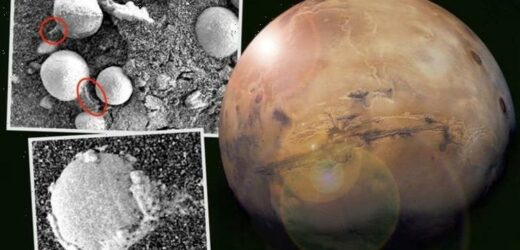NASA: ‘Mysterious light’ spotted on Mars image
When you subscribe we will use the information you provide to send you these newsletters. Sometimes they’ll include recommendations for other related newsletters or services we offer. Our Privacy Notice explains more about how we use your data, and your rights. You can unsubscribe at any time.
The search for life on Mars has been fruitless so far but a group of fringe ET researchers believe they have found the holy grail. According to a study published in the journal Advances in Microbiology, the Red Planet is teeming with alien life, although not the kind people might expect. Rather than little green men running around the barren, rusty-brown planet, the newly-published paper claims to have found evidence of lichen, mushrooms and other kinds of fungi on Mars.
The bizarre claim is based on a number of images taken at the planet’s surface as well as from orbit by the various rovers and probes studying Mars.
What scientists at NASA have identified as rocks, the study claims are alien puffballs, possibly seeded on Mars through cosmic interactions with Earth.
The researchers also claim to have witnessed mushrooms growing in real-time, comparing NASA pics taken many sols (Martian days) apart.
In one such case, a photo snapped on sol 1145 appears to show nine “spherical and semi-spherical specimens” jutting out of the ground in the planet’s Meridiani Planum region.
A photo snapped just three days later shows an additional 12 objects appearing seemingly out of the blue.
Could this be evidence of alien life? Or could it be wind sweeping away the soil and revealing more of the rocks?
In other cases, the researchers compared NASA pics of the “Martian specimens” to puffballs here on Earth, confidently stating these are very much the real deal.
The researchers wrote in their study: “It is well-established that a variety of terrestrial organisms survive Mars-like conditions.
“Given the likelihood Earth has been seeding Mars with life and life has been repeatedly transferred between worlds, it would be surprising if there was no life on Mars.
“However, in contrast to terrestrial organisms, Martian fungi, moulds, algae and other putative life-forms, would have evolved on and already be adapted to the low temperatures, intermittent availability of water, low amounts of free oxygen, and high levels of radiation that characterize the harsh Martian environment.”
The researchers added: “Growth, movement, alterations in location and shape, constitute behaviour, and coupled with life-like morphology, strongly support the hypothesis there is life on Mars.”
Among the study’s authors is Dr Rhawn Gabriel Joseph, a neurobiologist known for being involved with the pseudo journal Journal of Cosmology – a title that has attracted controversy in the past.
Aliens: Conspiracy theorist finds ‘structure’ on the moon
This should not have passed peer review. Embarrassing
Casey Dreier, The Planetary Society
In 2014, Dr Josephb filed a lawsuit against NASA, claiming the US space agency has failed to properly investigate evidence of alien life on Mars.
He staked his claim against a picture of a Martian rock that somewhat resembled a doughnut that had been stepped on.
And this is not the first time he has come out with claims of mushrooms growing on Mars – claims that have been thoroughly debunked by the scientific community.
He made the same claim last year in The Journal of Astrobiology and Space Science Research, stating the surface of Mars is covered with “thousands of mushroom-lichen-like formations”.
A similar study about “Martian fungi” proved equally controversial.
However, the study’s authors were forced to revise their claims after being challenged by the journal itself.
The researchers wrote: “That these may be living organisms ‘can be reasonably inferred through reference to analogous terrestrial’ organisms; although if they are in fact alive and biological is unknown.”
Casey Dreier, Chief Advocate and Senior Space Policy Adviser at The Planetary Society, has now challenged the paper, calling it “bad science” and “junk”.
He tweeted: “This is not, in fact, BIG NEWS. The hundreds of Mars scientists actually working on these missions did not somehow miss the presence of fungi, and anyone reading this paper should easily spot the (many, obvious) red flags.
“This should not have passed peer review. Embarrassing.”
In another tweet, he said: “Regardless, this paper is clearly BS (Bad Science). The editors at Advances in Microbiology should retract this junk.
“Or at the very least, they should feel bad about letting it through.
“I’ve heard critiques about peer-review in crisis, but this really brings it home.”
Life, as far we know it, does not exist on Mars as the planet is simply too inhospitable.
There is some hope life may have developed there billions of years ago when Mars resembled a young Earth, with surface waters and a lush atmosphere.
NASA’s Mars 2020 mission hopes to learn more about this possibility of life by drilling into the planet for rock and soil samples that may contain trace evidence of microfossils.
The space agency said: “Even if Mars is devoid of past or present life, however, there’s still much excitement on the horizon.
“We ourselves might become the ‘life on Mars’ should humans choose to travel there one day. Meanwhile, we still have a lot to learn about this amazing planet and its extreme environments.”
Source: Read Full Article






